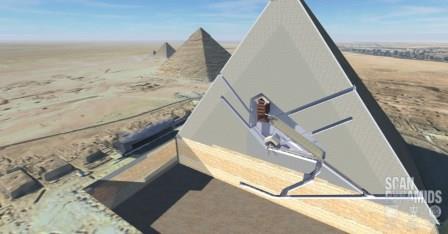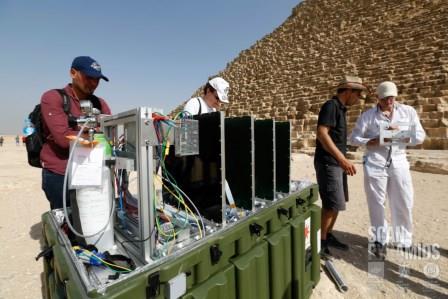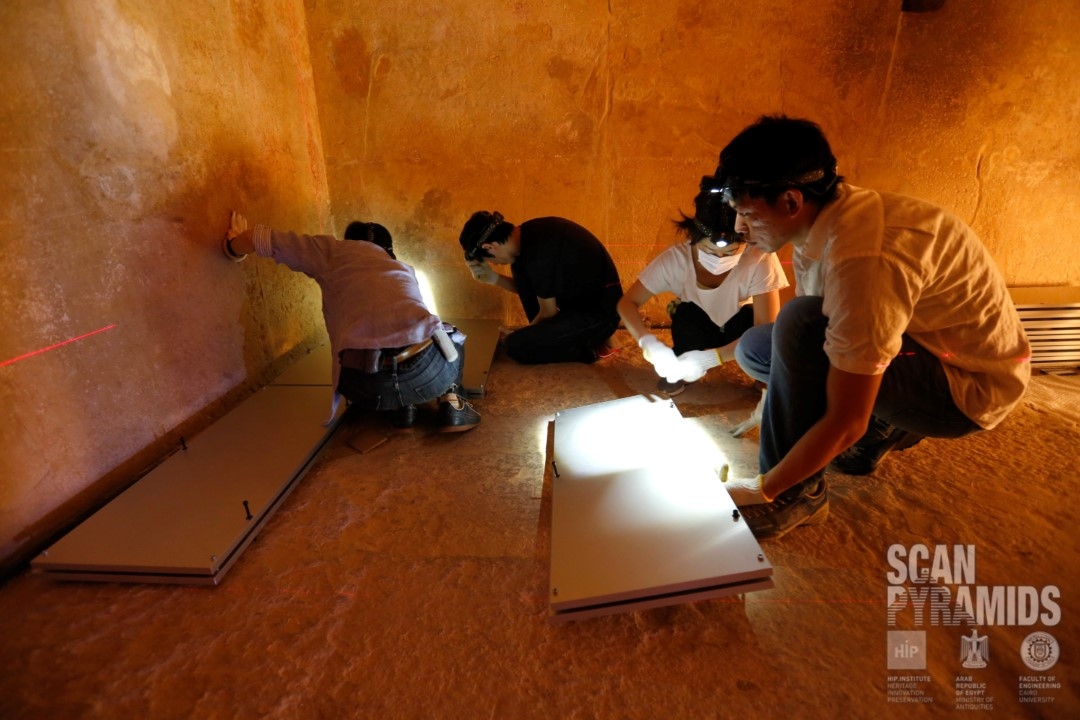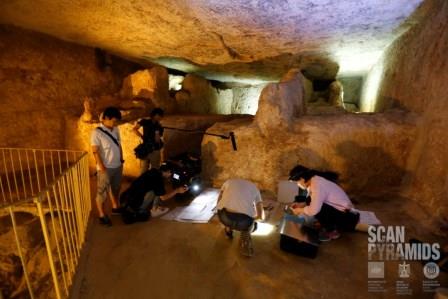Dopo essere stato in grado di dimostrare l'efficienza della tecnologia a muoni presso la Piramide di Bent in Dahshour il team dell'iniziativa internazionale #ScanPyramids, guidato dalla Facoltà di Ingegneria dell'Università del Cairo, e l'Istituto HIP sta ora installando la tecnologia non distruttiva a muoni nella piana di Giza allo scopo di svolgere una piena "scansione" della Grande Piramide, la nota Piramide di Cheope.
Il progetto #ScanPyramids sta attualmente scansionando la Grande Piramide di Giza utilizzando tre diverse tecniche, come descritto nel video riportato in fondo alla notizia.
- La prima tecnica è basata su emulsioni chimiche realizzate dall'Università di Nagoya, in Giappone, e collocati all'interno della Grande Piramide in luoghi diversi. In totale 80 film di emulsione saranno esposti al flusso naturale di muoni per 40 giorni prima di un lungo periodo di analisi.
- La seconda tecnica impiega rivelatori elettronici di gas appositamente fabbricati dal CEA (French Alternative Energies and Atomic Energy Commission), e sono stati collocati al di fuori della Grande Piramide. I rivelatori "Alhazen" e "Alvarez" saranno in esecuzione per un mese intero di calibrazione al fine di individuare i vuoti noti, e quindi saranno puntati a target specifici che cerceranno di identificare i vuoti sconosciuti. Un terzo rivelatore verrà utilizzato nei prossimi giorni.
- La terza tecnica è basata su scintillatore plastico elettronico ideato e realizzato dall'High Energy Accelerator Research Organization (KEK - Giappone) che si prevede venga collocato all'interno della Camera della Regina nel mese di luglio.
I risultati della nuova campagna a muoni eseguita dal team di #ScanPyramids saranno condivisi per l'analisi e l'interpretazione con diversi comitati che rappresentano diverse discipline scientifiche (fisica delle particelle, architettura, ingegneria meccanica, egittologia, archeologia, ecc). Un comitato di egittologi è stato formato dal Ministero delle Antichità, al fine di osservare i risultati del progetto #ScanPyramids. questo gruppo è guidato dal Dott. Zahi Hawass, ex ministro delle Antichità che sta operando sotto l'egida del Ministero delle Antichità.

3D View Cut of Khufu Pyramid.
Muons emulsion plate setup in Khufu's lower chamber.
Copyright: Egyptian Ministry of Antiquities, HIP Institute and the Faculty of Engineering (Cairo University).
Fonte: HIP Institute
English version
#ScanPyramids team deploys Muons detectors at Giza in order to “scan” Khufu’s Pyramid
Having been able to demonstrate the efficiency of Muons technology at the Bent Pyramid in Dahshour the international #ScanPyramids team lead by the Faculty of Engineering - Cairo University, and the HIP Institute is now deploying Muon non-destructive technology at Giza plateau aiming at performing a full “scan” of the Great Pyramid.
The #ScanPyramids project is currently “scanning” the Great Pyramid of Giza using three different techniques as described in the following video (below the news).
- The first technique is based on chemical emulsions made by Nagoya University (Japan) and placed inside the Great Pyramid at different places (Queen Chamber, Queen Chamber Niche, Lower Chamber). In total, 80 emulsion films will be exposed to Muons natural flow during 40 days before a long period of analysis.
- The second technique is employing gas electronic detectors specially fabricated by the CEA (French Alternative Energies and Atomic Energy Commission), and were placed outside the great pyramid. The “Alhazen” and “Alvarez” detectors will be running for a whole month of calibration in order to detect known voids, and then will be pointed to specific targets trying to identify unknown voids. A third detector will also be used in the next days.
- The third technique is based on plastic electronic scintillator conceived and made by the High Energy Accelerator Research Organization (KEK – Japan) which is planned to be placed inside the Queen Chamber in July.
Results of the new Muon campaign performed by the #ScanPyramids team will be shared for analysis and interpretation with several committees representing various scientific disciplines (physics particles, architecture, mechanical engineering, egyptology, archeology, etc.). A committee of Egyptologists have been formed by the Ministry of Antiquities, in order to observe the results of the #ScanPyramids project. The committee of egyptologits is led by Dr. Zahi Hawass, the former Minister of Antiquities, and is operating under the auspice of the Ministry of Antiquities.

ScanPyramids Muons Telescope setup in front of the Great Pyramid

ScanPyramids team with Dr Khaled El-Enany Ministry of Antiquities and Dr Zahi Hawass Egyptologist
Copyright: Egyptian Ministry of Antiquities, HIP Institute and the Faculty of Engineering (Cairo University).
More information on Muography
Muon particles permanently reach the Earth with a speed close to the speed of light and a flux around 10,000 per m² per minute. They originate from the interactions of cosmic rays created in the Universe with the atoms of the upper atmosphere. Similarly to X-rays which can penetrate our body and give access to bone imaging these elementary particles, also called “heavy electrons”, can go through hundreds of meters of stones before being absorbed. Judiciously placed detectors (for example inside a pyramid, below a potential, unknown chamber) can then record particle tracks and discern cavities (which muons cross with practically no interactions) from more dense regions in which some muons are absorbed or deflected. The challenge of such measurements consists in building extremely precise detectors and in accumulating enough of data (during several days or months) to increase the contrast.
The muography technique is nowadays frequently used in volcanology, in particular by the research teams of Nagoya University. Within the ScanPyramid mission, 3 types of detectors have been developed. Nagoya University uses chemical detectors based on silver emulsion films. The KEK has built an electronic device working with muon sensitive, scintillating plastics. Such instruments allowed in particular the imaging of the inside of nuclear reactors in Fukushima. Concerning the muon telescopes of CEA which joined the mission on April 15th, they are made of gaseous detectors based on an argon mixture. On the contrary to chemical emulsions, electronics instruments (plastic or gas) allow for a real time imaging.
Further information on #ScanPyramids: www.scanpyramids.org
Source: HIP Institute



